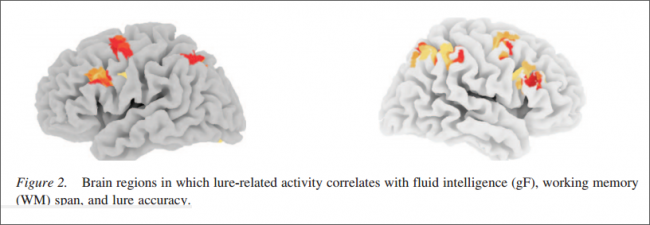Triangulating for Stable Results
Single peer-reviewed scientific studies are never enough. Scientists must compete, collaborate, and triangulate on phenomena with multiple methods in multiple labs. This produces stable results. One should ALWAYS be skeptical of the first results. Including one’s own.
Skepticism and the call for follow-up studies has been rightfully applied to Jaeggi and colleagues’ study showing fluid intelligence (Gf) gains from training with the dual n-back, back in 2008: Improving fluid intelligence with training on working memory. Gf is our reasoning and problem solving IQ, independent of cultural or background knowledge.
We are now at the end of August, 2014, and since 2008 dozens of labs have now run experimental studies looking closely at the effects of dual n-back training on Gf among other cognitive abilities such as attention, executive functioning and short term memory.
It is this kind of dual n-back training that i3 2G+ is built on.
IQ Gains from Dual N-Back Training: A Definitive Meta-Review Published in August 2014
This body of dual n-back research has now been collectively analyzed in a meta-study by Jacky Au and colleagues in their article:
Improving fluid intelligence with training on working memory: a meta-analysis
Their scientifically definitive study concludes:
“Our work demonstrates the efficacy of several weeks of n-back training in improving performance on measures of Gf. We urge that future studies move beyond attempts to answer the simple question of whether or not there is transfer and, instead, seek to explore the nature and extent of how these improved test scores may reflect “true” improvements in Gf that can translate into practical, real-world settings. (Au et al, 2014).
Not only is there a significant increase in IQ from n-back training, the effect generally observed in the scientific studies is likely to be an under-estimate, due to the following:
- The majority of subjects in these studies have been undergraduates. Sampling from restricted ranges of the total population usually biases effect sizes downward.
- The kind of ‘split-testing’ IQ tests used in these studies also causes downward biases in the effect size.
Thus the authors conclude:
“the results reported in this meta-analysis represent a low-end estimate of the true extent of improvement that n-back training can have on measures of Gf.”
The authors argue that evidence suggests the effect size could be further increased by optimizing certain parameters including:
- Program completion
- Increasing the internal motivation to engage in the exercise
- Reducing training session length to e.g. 15-20 minutes per session.
These are precisely features that have been optimized in our IQ Mindware apps i3 Mindware and HighIQPro, helping explain why I can confidently guarantee a 10-20 point IQ gain from 20 days of training.
IQ Mindware products build in incentives that stimulate intrinsic motivation to complete the 20 day program, and Session lengths are half the time of the standard dual n-back games investigated in the laboratory.
Dual N-Back & Interference Control
Brain imaging studies by Burgess, Gray, and fellow grad student Tod Braver (article 1) has found that brain regions common to fluid intelligence and working memory became more active when there was more need to filter out distractions (‘lures’). The brain areas underlying both interference control, working memory capacity and fluid intelligence were the lateral prefrontal cortex (lPFC) and parietal cortex, shown in the fMRI images below which show activation in both the left and right hemispheres of the brain.
This suggests a critical insight for optimizing IQ gains from training with the dual n-back:
- Building the need to filter out distractors (‘lures’) into the dual n-back game will result in greater IQ gains by exercising interference control.
This is precisely what I have done with the IQ Mindware apps. Interference control is an integral feature of the IQ Mindware dual n-back games. This type of dual n-back training is called 2nd generation (2G) n-back training. Standard dual n-back exercises do not build in interference control training.
Summary
Au’s meta-analysis of the dual n-back training literature – Improving fluid intelligence with training on working memory: a meta-analysis – helps resolve the controversies surrounding IQ gains from dual n-back training. Dual n-back training results in IQ gains, provided relevant criteria (such as program completion) are met.
For a more technical review supporting this conclusion that looks at additional meta-analyses and addresses critique papers such as Bayesian arguments, you can read this Review of 2014-2015 Meta-Analyses on Working Memory Training for IQ and Working Memory.
IQ Mindware apps – i3 Mindware and HighIQPro – have been optimized based on the recommendations outlined in the Au and colleagues’ meta-study. These apps also incorporate interference control – which standard dual n-backs do not. Interference control, we have found, is a key parameter for optimizing IQ gains from training.
Subscribe for free eBooks on IQ augmentation
[space]



How about this meta review: “Shipstead, Zach, Thomas S. Redick, and Randall W. Engle. “Is working memory training effective?.” Psychological bulletin 138.4 (2012): 628.”
Jacky Au and colleagues argue in their meta-review that the average increase in IQ from training they found is an under-estimate due to the samples and testing criteria. Moreover, they believe that the effect size they reported could be increased by optimizing certain game parameters including:
• Program completion
• Increasing intrinsic motivation for program completion
For these reasons the authors argue:
“the results reported in this meta-analysis represent a low-end estimate of the true extent of improvement that n-back training can have on measures of [intelligence]”.
The name of the game is now is determining precisely what parameters of dual n-back training can optimize wide transfer to IQ and general cognitive performance. An analogy is growing tomatoes. If you know you can grow them, your next concern is to figure out how to make them bigger and better – by e.g. different watering schedules or adding fertilizer or varying the growing temperature!
One strong candidate parameter for optimizing dual n-back training that I have been particularly interested in (and incorporated in my apps) is interference control.
Interference is a technical term for distracting information that is similar to the information you need to perform well in a game or cognitive challenge.
Or how about this meta review?
Melby-Lervåg, Monica, and Charles Hulme. “Is working memory training effective? A meta-analytic review.” Developmental Psychology 49.2 (2013): 270.
In this metareview, the researchers saw little evidence for the generalization of working memory training to other mental skills such as reading comprehension, word decoding, and arithmetic. But that’s not all they found. The researchers also found that working memory training programs do produce reliable short-term improvements in both verbal and visuospatial working memory skills.
How about this study prof. Mark?
Bogg, Tim; Lasecki, Leanne (22 January 2015). “Reliable gains? Evidence for substantially underpowered designs in studies of working memory training transfer to fluid intelligence”. Frontiers in Psychology 5.
Check this out.
If you look at the Bayesian study closely, you can see that a possible explanation of the results is related to cultural differences in conditions, not the issue of passive vs active controls – as explained in detail here.
This Bayesian study only says that from a Bayesian perspective we KNOW that there is a passive control effect, and we don’t know whether there is an active control effect (7 to 1 is not a sufficient probability to be considered ‘support’ of the null hypothesis when the standard we usually require is 20:1).
Well, that’s interesting. I wonder if it works.
There’s a new antidepressant expected next year-works in about 2 hours. It supposedly helps a lot to improve memory and problem solving by facilitating brain plasticity-modulating glutamate. And the drug? The envelope please: Glyx-13.